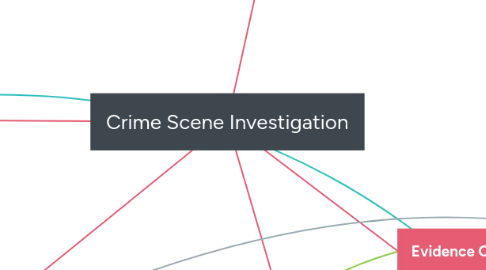
1. Documentation | Document everything in a crime scene before as well as after collection of evidence. Cautionary procedure needed during collection period as the investigator can destroy the evidence. In addition, it demonstrates the intial aspect before any contamination or any other units entering the scene to capture the "true" crime scene .
1.1. Sketching the Crime Scene
1.1.1. A sketch of the scene, including all the materials found with a proportional scale, aids in court as a visual aid.
1.2. Photography | Accurate scale (measurements) must be used, and the photos have to be 90 degrees from the evidence being collected, in addition of close ups of the items.
1.2.1. Attention to detail, photography of every evidence/scene before and after collection is needed for reference during court.
1.3. Documentation
1.3.1. Written report of all evidence collected, as well as the units and individuals that have entered the scene.
2. Equipment | Use of best methods and practices to ensure maximum detail in evidence
2.1. UV Light | Used to improve crime scene processes
2.2. Specialiized Machines
2.3. Powder | To lift fingerprints and footwear pattern
3. Lab Analysis | Evidence is then sent to the lab in order to verify and determine whether the evidence matchs with the suspect. Makes conclusions based on lab tests and evidence found.
4. Manpreet Kaur 1005218658 FSC239 - TUT0108 October 10th 2019
5. Evidence Collection
5.1. Secure Location
5.1.1. Want to minimize contamination. As well to preserve the points of entry and exit, and document those scenes before any analysis.
5.1.1.1. Look for evidence where suspect leaves the scene
5.2. Path of Contamination
5.2.1. Law enforcements close the scene off to keep it as is, documents the evidence, and creates a pathway for investigators to use in order to minimize contamination and record any evidence that is found in the original entry and exit points of the perpetrator.
5.3. Locating and marking evidence | Label and document every piece of evidence, position and conditions of the scene
5.3.1. Gather evidence through best methods and techniques with extreme detail and sealing it in the evidence bag to avoid contamination for lab analysis
6. Identify Evidence
6.1. Non-Biological Marterial
6.1.1. Fingerprints
6.1.2. Footwear Patterns
6.2. Biological Material
6.2.1. Bloodstain Patterns | can assist with the chronological order of the crime scene (the sequences of events)
6.2.2. DNA
6.2.3. Body Fluids
